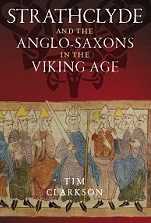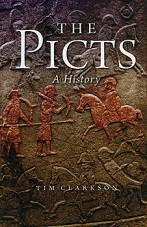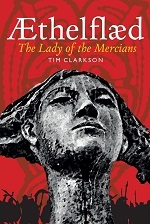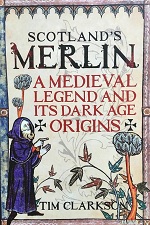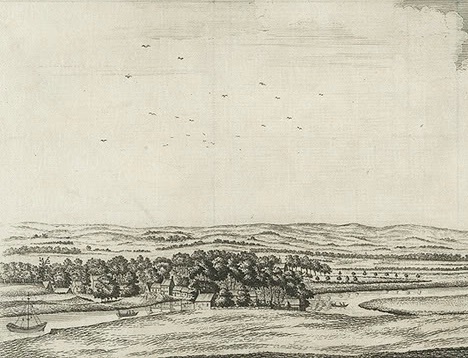
Govan in 1757, sketched by Robert Paul. Doomster Hill at left.
The Doomster Hill was a massive artifical mound that dominated the Govan landscape until its destruction in the mid-nineteenth century. The above illustration from 1757 shows it with a tiered or ‘stepped’ profile, a shape characteristic of sites used as assembly-places in the Viking period. It seems likely that it acquired this profile on the orders of the kings of Strathclyde, perhaps around AD 900 when the kingdom had close political contact with powerful Viking warlords in Dublin who had a man-made mound of similar shape. The Old Norse word for assembly is thing (pronounced ‘ting’) so it may not be too wide of the mark to speak of Govan’s ancient mound as a ‘thing site’. We can imagine it being used by the kings of Strathclyde as a venue for ceremonies and as a focus for public gatherings. It would have been part of an early medieval ‘ritual landscape’ which included not only a royal burial-ground and church (on a site now occupied by Govan Old) but also a processional pathway linking church and hill.

The 1757 sketch was re-worked nearly 150 years later by T.C.F. Brotchie.
In the past couple of years I’ve developed a keen interest in the Doomster Hill. This has been boosted in 2013 by my participation in a community heritage project called ‘Some Thing Is Missing’ (‘STIM’ for short). STIM’s main objective is ‘to bring together young volunteers from various backgrounds to investigate the history and heritage in Govan surrounding the mysterious historical site at Water Row: the Doomster Hill‘. The Thing in the title is the assembly or parliament held on the hill in the time of the kings of Strathclyde. Sometime before 1850, this huge ancient monument was completely destroyed, so it is therefore Missing from Govan’s present-day landscape. I am one of several ‘expert witnesses’ who have been providing historical, archaeological and geographical background so that the STIM team members (known as ‘landscape detectives’) get an idea of the different contexts in which the Doomster Hill site has functioned over time. In a series of workshops we’ve been exploring the layers of history that have made this part of Govan so significant.
One layer that I had not previously studied in detail is the period before the emergence of the kingdom of Strathclyde in the fifth century AD. I knew of a people recorded by the Romans as Damnonii (or Dumnonii) who inhabited the Clyde valley in the Iron Age, but I had never ventured further back into the Bronze Age or earlier. It’s a knowledge gap I needed to fill. Fortunately, at the first STIM workshop in July this year, Ingrid Shearer of Northlight Heritage gave an excellent introduction to prehistoric settlement in the lands around the River Clyde. This whetted my appetite to learn more, especially about the origins of the Doomster Hill itself. Ingrid and other archaeologists have surmised that the hill could have been a prehistoric barrow adapted and re-shaped by the kings of Strathclyde. An old report of bone fragments being dug out of the summit in the 1830s seems to support this theory, and my own discussions with Ingrid have persuaded me that it is probably correct.

The Doomster Hill: a prehistoric burial-mound?
At the beginning of September, I returned to Govan for another STIM workshop with the landscape detectives. This involved a morning session in which we examined the history of Viking Age assembly sites, followed by an afternoon walkabout around the western edge of the Riverside Housing Estate (where the Doomster Hill once stood). The detectives told me of an earlier walkabout in the same area with Ingrid Shearer and prehistorian Kenny Brophy, an account of which is available at Kenny’s blog. I’ve posted a link at the end of this post. Suffice to say, I’m now even more convinced that Govan’s ancient hill was already thousands of years old when the kings of Strathclyde turned it into a thing site. Interestingly, Kenny observes that the early medieval arrangement of hill, church and royal pathway might simply have maintained a ritual landscape whose origins reach far back into the remote past. He notes that Govan’s two historical eras of greatness – as a royal capital in the Viking Age and as a major shipbuilding centre 800 years later – may have been preceded by an even older one that we can barely glimpse today:
‘ … it seems very likely that the Doomster Hill started life not 1200 years ago, but perhaps more than 4000 years ago, a massive Neolithic or Bronze Age burial mound. If this were to be the case, then Govan had a third era of greatness, as a centre of power and pilgrimage in prehistory.’
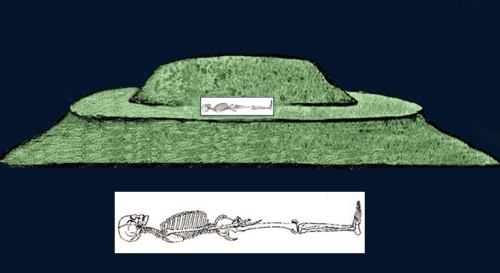
The Doomster Hill re-shaped as a stepped mound or thing site, c.900 AD. Did it still contain a prehistoric burial, traces of which were rediscovered in the 1830s?
* * * * * * *
Links:
Some Thing Is Missing: the landscape detectives have a project blog, a Facebook page and a Twitter account. The project is based at Fablevision on Water Row, overlooking the Doomster Hill site.
The Doomster Hill gets a mention at the website of the international Thing Sites project.
Northlight Heritage is involved in a number of projects at Govan including the recent redisplay of the Govan Stones.
My online article on the Doomster Hill gives a historical summary of the site.
* * * * * * *

